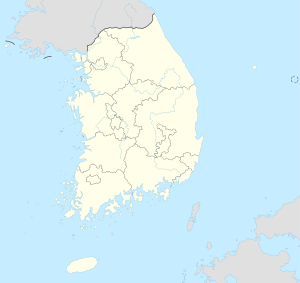Boryeong
| Boryeong | |||
|---|---|---|---|
| Korean alphabet : | 보령시 | ||
| Chinese characters : | 保 寧 市 | ||
| Revised Romanization : | Boryeong-si | ||
| McCune-Reischauer : | Poryŏng-si | ||
| Basic data | |||
| Province : | Chungcheongnam-do | ||
| Coordinates : | 36 ° 20 ′ N , 126 ° 37 ′ E | ||
| Surface: | 569 km² | ||
| Residents: | 104,162 (as of 2019) | ||
| Population density : | 183 inhabitants per km² | ||
| Structure: | 1 eup , 10 myeon , 5 dong | ||
| map | |||
|
|||
Boryeong ( 보령시 ) is a city on the coast of the South Korean province of Chungcheongnam-do with an area of 569 km² and a population of 104,162 inhabitants in 2019. It has a railway station on the Janghang Line, which it connects with over the Gyeongbu Line South Korea's capital Seoul connects. It is also connected to the Seohaean motorway route .
Boryeong is known in Korea for its beaches, especially Daecheon Beach, and its annual mud festival in July, Boryeong Mud Festival . The festival attracts 2 million visitors annually. The city's beach mud is widely touted for its cosmetic properties. As everywhere on the southwest coast of the Korean peninsula, there are numerous small islands, many of which are connected to the port of Daecheon by ferry.
Boryeong reached its current limits in 1995 with the merger of Boryeong-gun and Daecheon-si. The two units had previously been separated in 1986 and had previously been united under the name Boryeong-gun since the Joseon Dynasty .
Infrastructure
The city is connected to the rest of the country via a train station and several national roads.
Sister cities
sons and daughters of the town
- Park Jang-soon (* 1968), wrestler
Individual evidence
- ^ Boryeong-si (city, Chungcheongnam-do, South Korea) - population statistics, charts, map and location. Retrieved July 20, 2020 .
- ↑ Boryeong Mud Festival: Korea.net: The official website of the Republic of Korea. Retrieved July 20, 2020 .

